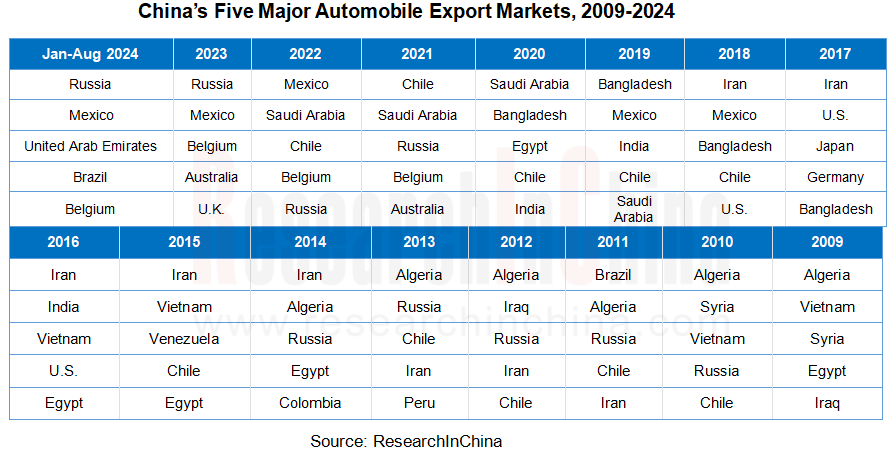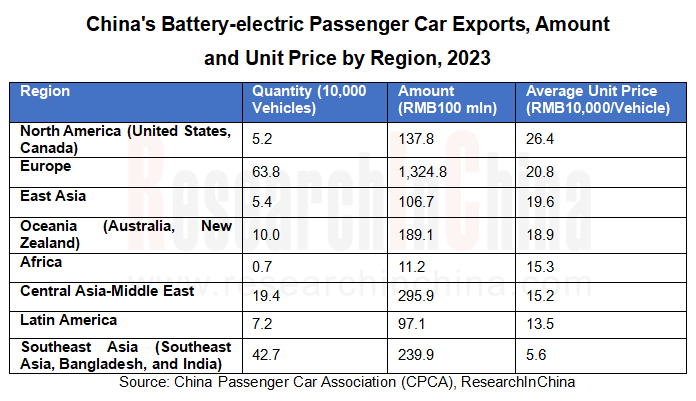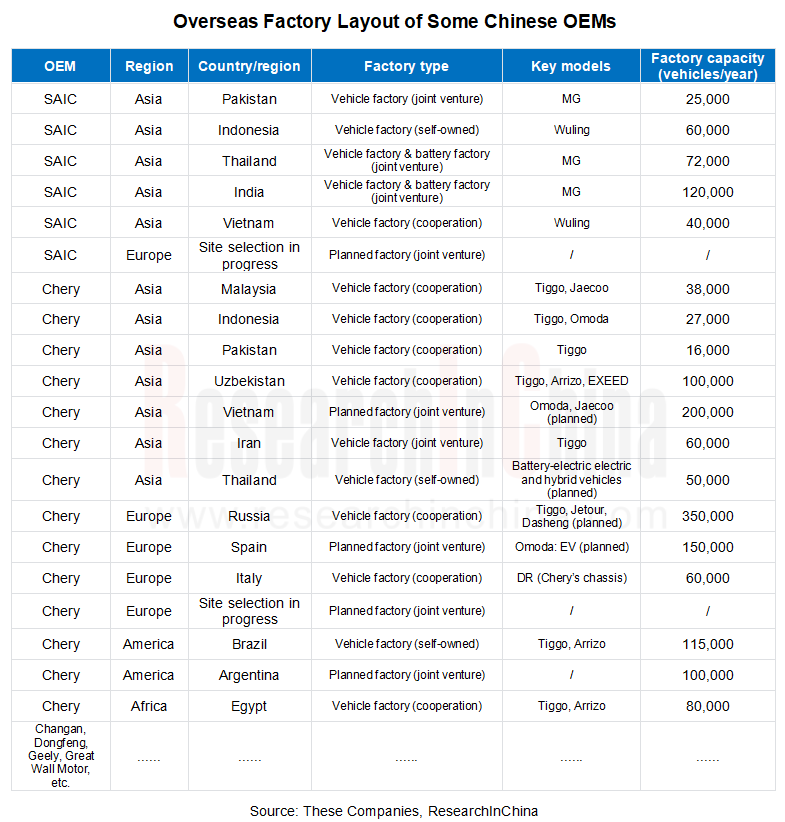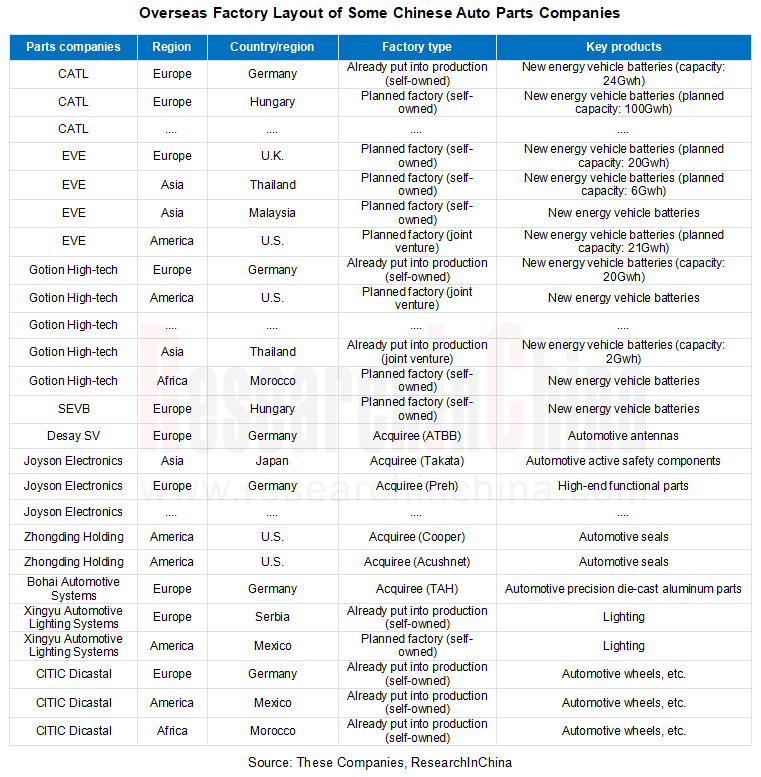Research Report on Overseas Layout of Chinese Passenger Car OEMs and Supply Chain Companies, 2024
Research on overseas layout of OEMs: There are sharp differences among regions. The average unit price of exports to Europe is 3.7 times that to Southeast Asia.
The Research Report on Overseas Layout of Chinese Passenger Car OEMs and Supply Chain Companies, 2024 analyzes the status quo of China's automobile exports, overseas data, overseas automotive industry policies and other macro-environments; the status quo the automotive markets, tariff and subsidy policies, and performance of Chinese brands in key countries and regions such as Russia, Mexico, Saudi Arabia, Germany, Thailand, Japan, South Korea, Chile, France, Belgium, etc.; the overseas performance, expansion strategies, and factory construction and layout of OEMs such as SAIC, Chery, Changan, Dongfeng, Geely, Great Wall Motor, BYD, NIO, Neta, and Xpeng; the overseas production, R&D, and market layout of automotive supply chain companies such as CATL, CALB, FinDreams Battery, SVOLT Energy, EVE, Gotion High-tech, Desay SV, Ecarx, Hangsheng Electronics, Zhongding Group, Bohai Automotive Systems, Xingyu Automotive Lighting Systems and Fuyao Glass.
Passenger car exports: Europe is the largest export market of battery-electric vehicles, with the average export unit price 3.7 times that to Southeast Asia.
China's automobile exports have continued to grow at a high rate since 2022. Facing challenges from complex and changing external environments, ever more OEMs also have to make cautious deployments in overseas markets while accelerating their overseas market layout plan. The next three years are an important time node for Chinese OEMs to implement overseas strategies, and they need to closely track the internal and external environments.
In August 2024, China exported 610,000 vehicles, a year-on-year upsurge of 39% and a month-on-month growth of 10%. From January to August, China exported 4.09 million vehicles, surging by 27%. The main boosters to China's automobile exports in 2024 are still the higher penetration rate of new energy vehicles in the global market, the greater competitive edges of Chinese automobiles, and the small growth in the European and American automotive markets. In particular, the more competitive Chinese fuel-powered vehicles in the Russian and Middle Eastern markets boost the exports.
From January to August 2024, China's passenger car exports (42% of were new energy vehicles) swept 84.2% of the total automobile exports. Developed European countries such as Belgium and the United Kingdom also became important export markets for Chinese new energy vehicles.
From the changes in the five major export markets of Chinese automobiles from 2009 to 2024, it can be seen that:
Before 2016, China mainly exported automobiles to Middle East, Southeast Asia, and Latin America;
After 2017, economically developed countries such as Belgium, Australia, Saudi Arabia, and the United Kingdom became the main destinations for China's automobile exports. It was also this year that the General Administration of Customs of the People's Republic of China began to include new energy vehicles in statistics for the first time.
Before the Sino-US trade friction, the United States often ranked among China's top five automobile export markets, but it has not been shortlisted since 2019. In September 2024, the US government officially locked in steep tariff hikes on Chinese imports, including a 100% duty on electric vehicles, which makes it more difficult for Chinese vehicles to enter the US market.
Since 2021, with the growth of new energy vehicle exports, developed countries have begun to become export destinations of Chinese automobiles frequently. The development of new energy vehicles has brought China's automobile exports into a critical window period of all-round upgrading and transformation from product export to technology export, service export, and brand export.

Europe is the largest export market for Chinese battery-electric vehicles. In 2023, China exported 640,000 battery-electric vehicles valued at RMB132.5 billion to Europe, with the average unit price of RMB208,000, 3.7 times that (RMB56,000) to Southeast Asia. The export of new energy vehicles to Europe and the United States has not only brought about "quantitative changes" but also "qualitative changes." Chinese OEMs have begun to enter overseas markets in a systematic and organized manner by establishing a perfect service system from overseas production to operations, sales, and R&D.

Amid countervailing investigations, increased tariffs, and even more stringent market access policies, China's automobile exports face challenges, but the solid foundation of China's automotive industry, complete automotive electronics industry chain, leading intelligent vehicle connection technology, and mature industrial worker system lay a firm foundation for the constant growth of China's automobile exports.
Overseas layout of OEMs: New vehicle factories gather in Thailand, and Europe will be the future layout focus.
Today, China is no longer simply exporting automobiles. Ever more OEMs begin to build after-sales service systems overseas.
SAIC established a European parts center in Amsterdam, the Netherlands, to offer after-sales services; it opened a second European parts center in France in the summer of 2024. SAIC has more than 2,800 marketing and service outlets around the world, of which MG has over 400 marketing and service outlets in Europe and 2 parts centers in the Netherlands and Belgium.
In September 2024, BYD announced that it had entered into an agreement with Hedin Mobility Group (BYD's dealer in Germany and Sweden) to acquire Hedin Electric Mobility GmbH and transfer the distribution activities of BYD vehicles and spare parts in the German market to BYD Automotive GmbH. The transaction also includes a business transfer of the two pioneer stores in Stuttgart and Frankfurt which are operated by Hedin Mobility Group. Therefore, BYD will no longer rely on German importers and will directly contact local dealers instead.
NIO has built the NIO Power Europe Plant in Pest, Hungary. The factory will serve as the operational fulcrum of the European strategy and will mainly produce swap stations that provide battery swap services for electric vehicles. It specializes in battery swap station manufacturing and after-sales services, NIO's European power-up business training, and the R&D of power-up products.
Some OEMs have begun to deploy their automotive technologies overseas.
In 2023, SAIC announced that it would cooperate with Audi to jointly develop technology. Audi and SAIC have decided to jointly develop new models built on a China-specific platform named “Advanced Digitized Platform” for the next generations of premium intelligent, connected vehicles (ICV).
At the end of 2023, Stellantis acquired an about 20% stake in Leapmotor for EUR1.5 billion. Through this acquisition, Leapmotor will provide electrification technology to Stellantis which will produce electric vehicles at its Turin plant in Italy.
Starting in 2024, Xpeng may earn corresponding fees by providing technical services to Volkswagen.
Of course, the establishment of overseas factories by OEMs has always been on the agenda of OEMs as the main measure to deal with tariffs and trade barriers. From the perspective of the overseas factory layout of Chinese OEMs:
The KD production model of cooperating with local factories in overseas markets has become relatively mature, but new cooperative manufacturers are still joining. In September 2024, Dongfeng Motor Corporation and Sudan G Group officially signed a contract to launch a new automobile assembly model dubbed "Made in China + Sudan". In September 2024, Geely inked an agreement with Vietnam-based Tasco to co-fund an automobile assembly plant in Thai Binh, Vietnam that assembles automobiles in the form of CKD. In January 2024, Great Wall Motor officially signed a contract on CKD with EP Manufacturing Berhad (EPMB), a large listed manufacturing group company in Malaysia, starting the assembly and production of GWM’s automobiles.
Chinese OEMs prefer to build overseas factories in Asia. Many of the new energy vehicle factories are planned to be built sin Europe, but with pending locations. New factories planned in Thailand, Indonesia, Brazil and other places will be constructed faster. The new factory planned by Changan in Thailand is located in an industrial park in Rayong Province. The BYD factory there was put into production in July 2024. There are also factories of SAIC MG, Chery, Great Wall Motor GAC and Neta in this province. See the Chinese OEMs (Passenger Car) Going Overseas Report, 2024 - Thailand for details.
Differing from SAIC’s acquisition of MG and Geely's acquisition of Volvo for the purpose of quickly deploying overseas markets, some Chinese OEMs have directly took over some factories transferred by other OEMs overseas to achieve overseas deployment at the lowest cost and fastest time. For example, BYD is set to revamp a defunct Ford factory in Cama?ari, Bahia, Brazil, which closed in 2021, and start production at the plant in 2025. Great Wall Motor took over the GM factory in Thailand on November 2, 2020. Chery's Spanish factory was originally owned by Nissan Motor Iberica. The joint venture factory between JSW Group and SAIC in India was formerly the Indian factory of GM.
In general, Chinese OEMs have begun to accelerate the construction of their own overseas factories, especially in Southeast Asia and Latin America; but they are relatively more cautious in the layout of factories in Europe and the United States. Despite difficulties, they still take this step unhesitatingly.

Supply chain companies going overseas: In the early days, they mainly acquired traditional parts companies. Now battery companies plan to build their own factories around the world
Chinese auto parts companies have also begun to accelerate their overseas layout. Chinese suppliers such as CATL, Gotion High-tech, Desay SV, and Joyson Electronics all have factories in Europe and have entered the supply chain of local European OEMs.
Traditional auto parts companies, such as automotive glass, interior parts, seals and die-casting parts suppliers, have already made layout overseas early. Some companies have expanded their overseas markets by way of acquiring overseas auto parts companies. Examples include Desay SV's acquisition of Germany-based ATBB, Joyson Electronics' acquisition of Germany-based Preh and QUIN, and Zhongding Holding's acquisition of Germany-based AMK and KACO. There are also multiple companies that have built their own factories overseas, for example, Xingyu Automotive Lighting Systems in Serbia, CITIC Dicastal in Germany, the Czech Republic and other European and American countries, and Tuopu Group in Poland.
Compared with OEMs which prefer to build their own factories in Southeast Asia, auto parts companies tend to build factories in Europe, especially in Germany maybe because they can serve the European automotive industry conveniently, and Germany boasts a mature automotive industry and abundant talents and its local governments support the investment and development of Chinese companies. See the Chinese OEMs (Passenger Car) Going Overseas Report, 2024 – Germany for details.
Chinese companies have advantages in cost and technology for mass production of batteries. As European OEMs speed up the electrified transformation in their local markets, Chinese battery companies are accelerating their plans to build factories in Europe to meet the European market's surging demand for power batteries. Hungary has become one of the most popular export destinations for Chinese battery companies. CATL, EVE, BYD, and SEVB have all planned to build factories in Hungary. Chinese battery companies frequently invest in Hungary mainly because of the country's complete automotive industry chain and its location as the center of Europe. The Hungarian government also hopes to turn the country into a manufacturing hub for electric vehicles, batteries and other new technologies with the help of Chinese investors.

While electric vehicle and parts companies are expanding overseas markets, Chinese intelligent driving solution suppliers have also made their foray into overseas markets by setting up overseas R&D centers and launching overseas market projects. Pony.ai plans to establish a regional R&D center in Luxembourg to focus on the exploration and R&D of cutting-edge fields of autonomous driving. Pony.ai has already built cooperation on autonomous driving technology and application in South Korea, Luxembourg, Saudi Arabia, the United Arab Emirates and more. iMotion positions its German subsidiary as a European engineering and technology center to fully meet challenges from regulations, policies, traffic environments, and R&D processes. WeRide has successfully commercialized autonomous driving in the United States, the United Arab Emirates, France, Singapore, and other places, involving robobuses, robotaxis, and sanitation vehicles.
Autonomous Driving Domain Controller and Central Computing Unit (CCU) Industry Report, 2025
Research on Autonomous Driving Domain Controllers: Monthly Penetration Rate Exceeded 30% for the First Time, and 700T+ Ultrahigh-compute Domain Controller Products Are Rapidly Installed in Vehicles
L...
China Automotive Lighting and Ambient Lighting System Research Report, 2025
Automotive Lighting System Research: In 2025H1, Autonomous Driving System (ADS) Marker Lamps Saw an 11-Fold Year-on-Year Growth and the Installation Rate of Automotive LED Lighting Approached 90...
Ecological Domain and Automotive Hardware Expansion Research Report, 2025
ResearchInChina has released the Ecological Domain and Automotive Hardware Expansion Research Report, 2025, which delves into the application of various automotive extended hardware, supplier ecologic...
Automotive Seating Innovation Technology Trend Research Report, 2025
Automotive Seating Research: With Popularization of Comfort Functions, How to Properly "Stack Functions" for Seating?
This report studies the status quo of seating technologies and functions in aspe...
Research Report on Chinese Suppliers’ Overseas Layout of Intelligent Driving, 2025
Research on Overseas Layout of Intelligent Driving: There Are Multiple Challenges in Overseas Layout, and Light-Asset Cooperation with Foreign Suppliers Emerges as the Optimal Solution at Present
20...
High-Voltage Power Supply in New Energy Vehicle (BMS, BDU, Relay, Integrated Battery Box) Research Report, 2025
The high-voltage power supply system is a core component of new energy vehicles. The battery pack serves as the central energy source, with the capacity of power battery affecting the vehicle's range,...
Automotive Radio Frequency System-on-Chip (RF SoC) and Module Research Report, 2025
Automotive RF SoC Research: The Pace of Introducing "Nerve Endings" such as UWB, NTN Satellite Communication, NearLink, and WIFI into Intelligent Vehicles Quickens
RF SoC (Radio Frequency Syst...
Automotive Power Management ICs and Signal Chain Chips Industry Research Report, 2025
Analog chips are used to process continuous analog signals from the natural world, such as light, sound, electricity/magnetism, position/speed/acceleration, and temperature. They are mainly composed o...
Global and China Electronic Rearview Mirror Industry Report, 2025
Based on the installation location, electronic rearview mirrors can be divided into electronic interior rearview mirrors (i.e., streaming media rearview mirrors) and electronic exterior rearview mirro...
Intelligent Cockpit Tier 1 Supplier Research Report, 2025 (Chinese Companies)
Intelligent Cockpit Tier1 Suppliers Research: Emerging AI Cockpit Products Fuel Layout of Full-Scenario Cockpit Ecosystem
This report mainly analyzes the current layout, innovative products, and deve...
Next-generation Central and Zonal Communication Network Topology and Chip Industry Research Report, 2025
The automotive E/E architecture is evolving towards a "central computing + zonal control" architecture, where the central computing platform is responsible for high-computing-power tasks, and zonal co...
Vehicle-road-cloud Integration and C-V2X Industry Research Report, 2025
Vehicle-side C-V2X Application Scenarios: Transition from R16 to R17, Providing a Communication Base for High-level Autonomous Driving, with the C-V2X On-board Explosion Period Approaching
In 2024, t...
Intelligent Cockpit Patent Analysis Report, 2025
Patent Trend: Three Major Directions of Intelligent Cockpits in 2025
This report explores the development trends of cutting-edge intelligent cockpits from the perspective of patents. The research sco...
Smart Car Information Security (Cybersecurity and Data Security) Research Report, 2025
Research on Automotive Information Security: AI Fusion Intelligent Protection and Ecological Collaboration Ensure Cybersecurity and Data Security
At present, what are the security risks faced by inte...
New Energy Vehicle 800-1000V High-Voltage Architecture and Supply Chain Research Report, 2025
Research on 800-1000V Architecture: to be installed in over 7 million vehicles in 2030, marking the arrival of the era of full-domain high voltage and megawatt supercharging.
In 2025, the 800-1000V h...
Foreign Tier 1 ADAS Suppliers Industry Research Report 2025
Research on Overseas Tier 1 ADAS Suppliers: Three Paths for Foreign Enterprises to Transfer to NOA
Foreign Tier 1 ADAS suppliers are obviously lagging behind in the field of NOA.
In 2024, Aptiv (2.6...
VLA Large Model Applications in Automotive and Robotics Research Report, 2025
ResearchInChina releases "VLA Large Model Applications in Automotive and Robotics Research Report, 2025": The report summarizes and analyzes the technical origin, development stages, application cases...
OEMs’ Next-generation In-vehicle Infotainment (IVI) System Trends Report, 2025
ResearchInChina releases the "OEMs’ Next-generation In-vehicle Infotainment (IVI) System Trends Report, 2025", which sorts out iterative development context of mainstream automakers in terms of infota...